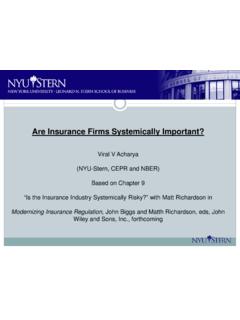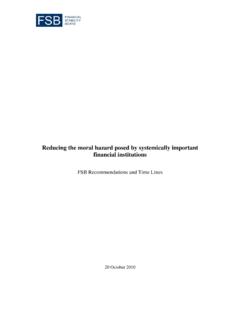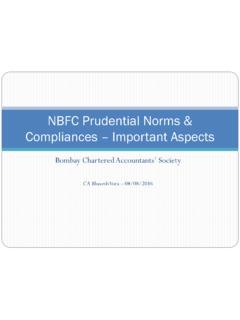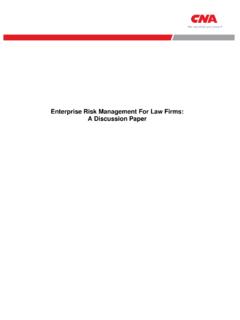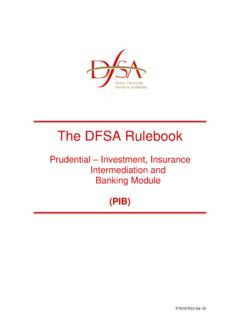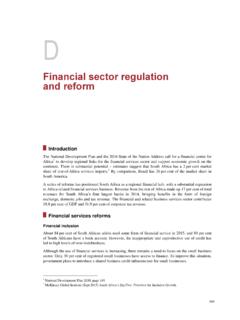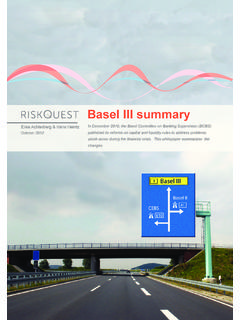Transcription of Credit risk management - EY
1 Credit risk management Why it matters and how insurers can enhance their capabilities As enterprise risk management has moved up the strategic agenda for insurance executives in the years since the global financial crisis, insurers have formalized and standardized policies and processes for managing different types of risks . In many cases, the role of risk management groups is clearly defined. When it comes to Credit risk management , however, insurers have varying approaches. At some carriers, the risk management group plays a basic oversight role, while at other firms it more broadly and deeply involves Credit and portfolio risk monitoring. With increasing regulatory pressure and ongoing economic turbulence, Credit risk management is moving up the agenda for senior management . In fact, many insurers are making significant investments to strengthen their Credit risk management capabilities and infrastructure.
2 Specifically, they are seeking to use data and analytics to gain more insight into the exposure to different types of Credit risks and to make smarter Credit risk decisions. Some insurers are likely to find that they are not investing aggressively enough to boost their risk-adjusted returns. 2. The meaning and types of Credit risk in insurance Credit risk is usually defined as the risk of loss due to the inability or limited willingness of a borrower (obligor), issuer or counterparty to meet its financial obligations. For insurers, the sources of Credit risk may include: 1 2 3 4. Investment portfolio risk Generally, this is the largest and most prevalent type of Credit risk for insurers. Investment Counterparty risk Transactions involving financial derivatives present unique risks to insurers, starting Reinsurance counterparty risk When an insurance company cedes risks to a reinsurer, it assumes the risk that the reinsurance Country risk or transfer risk Country risk primarily arises from the socioeconomic turbulence or political uncertainty in portfolios typically with the possibility that company defaults and a foreign country.
3 Transfer include bonds, structured counterparties will be will be unable to fulfill risk results mainly from transactions and secured unable to meet their its obligations. In such a lack or restriction of lending ( , mortgage obligations, requiring an event, the insurance foreign exchange required loans), among others. The replacement with a company will then need to fulfill obligations. risk for the investment different counterparty and to fund and maintain Given the interconnected portfolio involves the potentially resulting in a adequate reserves. global economy, and the likelihood that investments loss depending on market solid returns that some will fall in value as a result rates at the time of the emerging markets can of rating downgrades, transaction. provide, country risk must issuer (or borrower) be on the agenda of risk default, Credit spread management groups.
4 Changes, macroeconomic cycles or conditions, or other factors. The extent of the risk varies based on the quality, value and volatility of assets in an insurer's investment portfolio. 3. Why Credit risk matters for insurers Credit risk is an increasingly important matter in the insurance industry because of the central role it plays in the investment portfolios in the industry. Given that insurers accept premiums and maintain capital reserves to cover the potential cost of future claims, Credit risk speaks to the very heart of the insurance business. Insurers also face increased Credit risk in terms of their investments, especially now that: More insurers have turned to high-risk assets in search of higher yields and better investment results. The prospect of a national government defaulting on its obligations seems more likely today than just a few years ago. A number of once-stable industries (utilities and telecoms, among others) have been downgraded.
5 Globalization and other macroeconomic trends make it harder to quarantine . downgrades or defaults to one sector or region. Regulatory constraints including the way that National Association of insurance Commissioners (NAIC) and local regulatory regimes skew exposure to sovereigns and financial institutions can exacerbate Credit risk issues. For instance, concentration risk refers to any single exposure or group of similar exposures that have the potential to produce losses large enough to threaten the insurance company's creditworthiness or ability to maintain its core operations (relative to an insurer's earnings, capital, total assets or overall risk level). Concentration risk may include exposures to a specific counterparty, an industry or economic sector or a geographic region. Concentration risk may also arise from Credit risk mitigation techniques and exposures to counterparties used for execution or processing (such as hedge funds and hedge counterparties).
6 Then there are relatedness risks , which exist when the size of exposure is correlated to the creditworthiness of the counterparty. Right-way exposure means exposure increases as a counterparty's creditworthiness improves, while wrong-way exposure means exposure increases when a counterparty's creditworthiness decreases. Relatedness risks may arise from foreign exchange fluctuations, interest rate swaps, equity derivatives and collateral, as well as through exposure to systemically important financial institutions (SIFIs) and sovereign wealth funds. 4. Insurers were made all too painfully aware of these and Property and casualty (P&C) insurers other risks during the financial crisis of 2008 2009, as P&C carriers make their money on underwriting loss well as the dotcom bust of the early 2000s. In both ratios, but they still have a large asset base to invest. of these cases, many insurers only realized too late the Many P&C carriers may not be taking on enough risks depth and breadth of their sector-specific exposures.
7 In their investments. Still, Credit risk is usually the For example, ambiguous contracts concealed just how second-largest risk faced by P&C firms, behind the risk of many different industries would be affected or damaged catastrophes causing claims to spike. by the mortgage crisis. Lacking sufficient stress-testing programs, scenario modeling capabilities or a system of By better understanding their Credit risk exposures, all triggers to alert them to these risks , insurers failed to see types of insurers will be able to more effectively manage the underlying interdependencies and suffered severe and diversify risks with a significant potential upside for economic consequences as a result. their bottom line. Mutual companies can return money to policyholders, while publicly traded firms can improve The industry supervisory groups and global regulators the return on equity.
8 Thus, Credit risk management that have studied the crisis have concluded that a major should be focused on implementing and maintaining the cause was the lack of forward-looking views of Credit right guardrails so that the business can take appropriate risk. Today, insurers may have similarly serious concerns risks in pursuit of better risk-adjusted returns. about overexposure to the oil industry or certain government debt. The imperatives to avoid similar scenarios in the future and to improve portfolio performance are driving Lessons from banking many insurers' investments in more robust Credit risk management capabilities today. They are also leading Insurers can apply the lessons learned many insurers to go beyond minimum standards for from experience of the banking sector regulatory compliance as a means to gain much deeper and more precise views of their Credit risk.
9 With Credit risk management . First and foremost, because of the nature of their The need and business case for Credit risk management varies by type of insurance company. business, banks must be extraordinarily effective and disciplined in Credit risk Life insurers and annuity providers management . Secondarily, banking These carriers need insight into Credit risk to avoid executives have learned to view overexposing their investments to one asset class or sector a critical consideration with interest rates regulatory and supervisory guidance as remaining at or near record lows. Credit risk is typically a source for good business practices. the second-largest risk faced by life insurance and Neither banks nor insurers like annuity companies, after only market risk (interest rate and equity price changes), and thus should be viewed in regulation, but there is value for those context of long-term exposures.
10 Firms and executives who know where to find it. 5. The Credit risk management road map: a proven approach A building-block approach to Credit risk management that guidance and positioning it as a requirement for has proven effective at many firms. The foundational investing the firm's assets is the first step to managing building blocks must be in place before more essential Credit risk exposure. and advanced capabilities can be established to support Starting from the risk appetite statement, insurers will various levels of risk management activities. The primary then typically seek to set Credit risk limits by several steps insurers should follow are outlined below. categories, including: Define the right Credit risk appetite and Rating class or average rating Credit risk limits Name-level Credit risk exposures Industry or economic sectors Multiple stakeholders across the company should be involved in the broad-based process for determining Geographical limits the parameters for investment decisions, including tolerable Credit exposures, the likelihood of losses and When it comes to setting limits for economic capital, these the risk profiles of specific investments.










